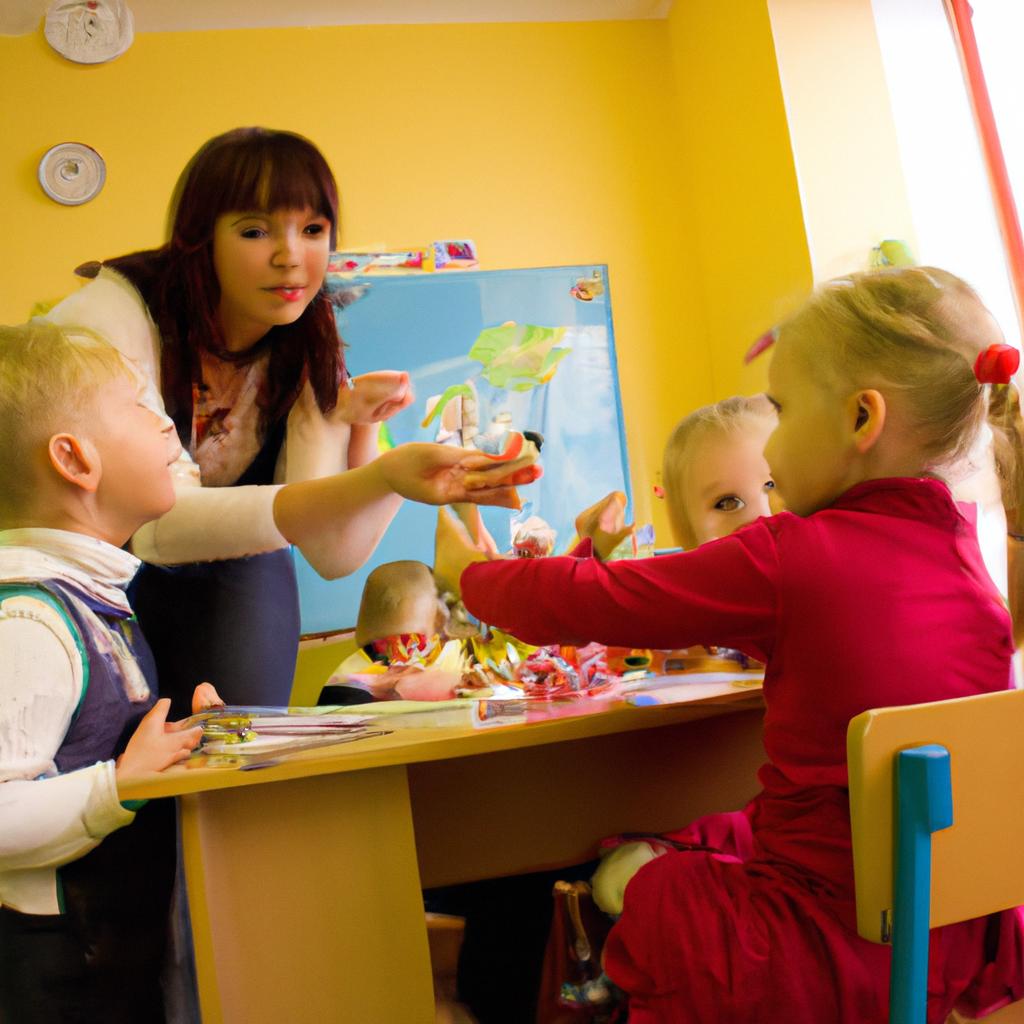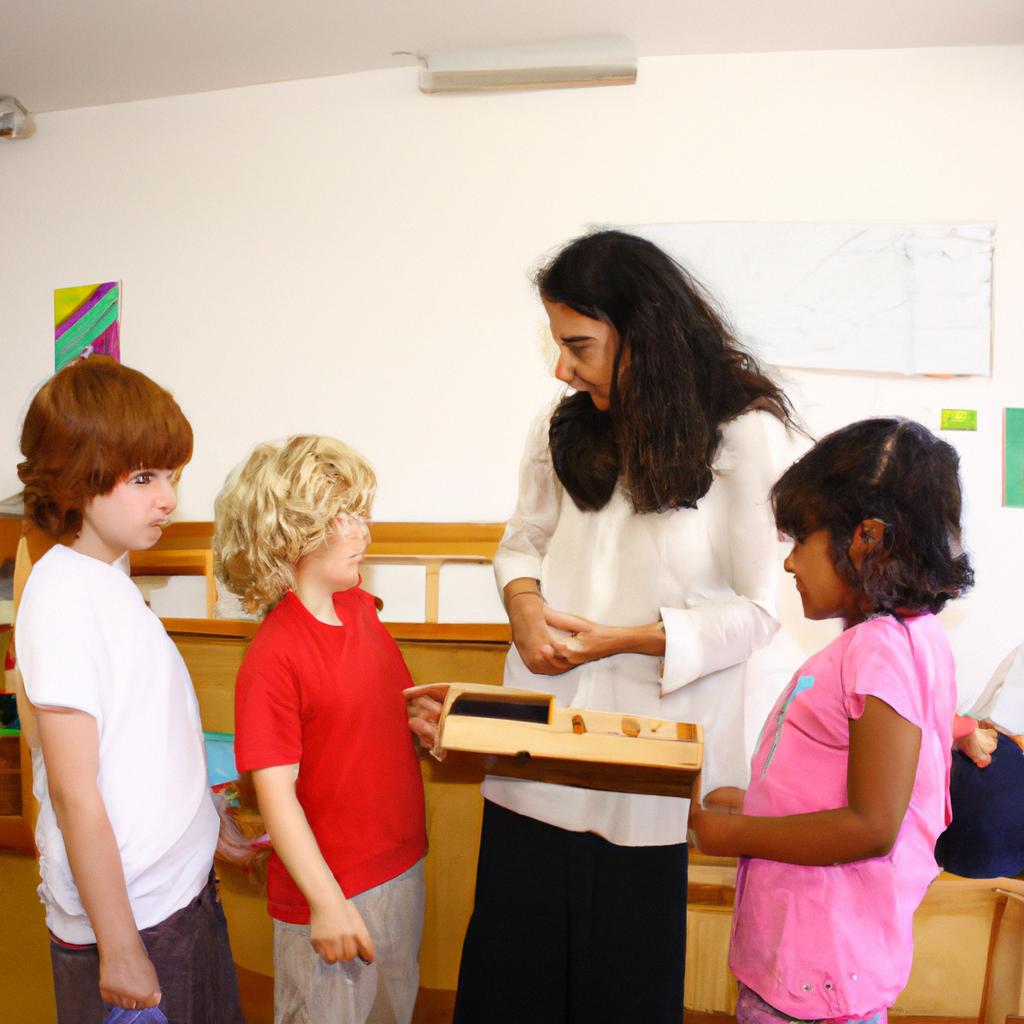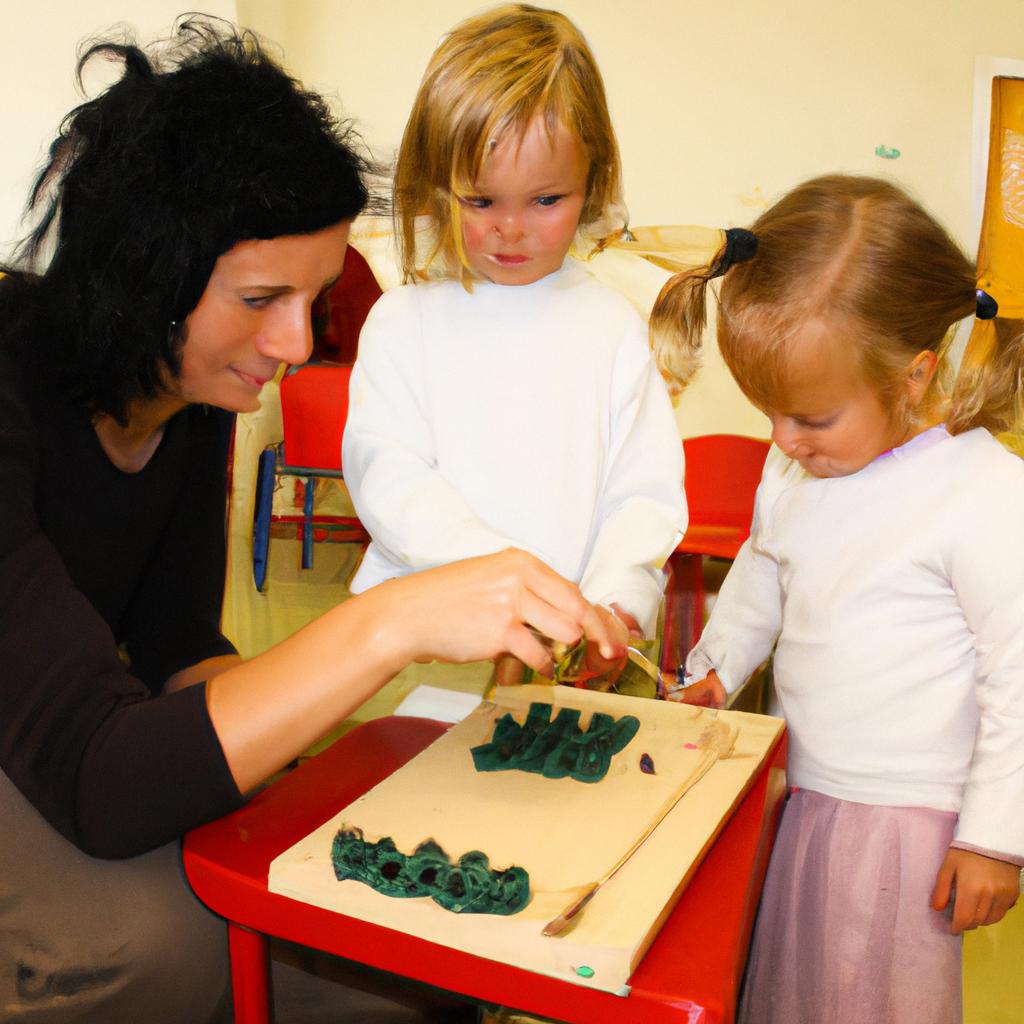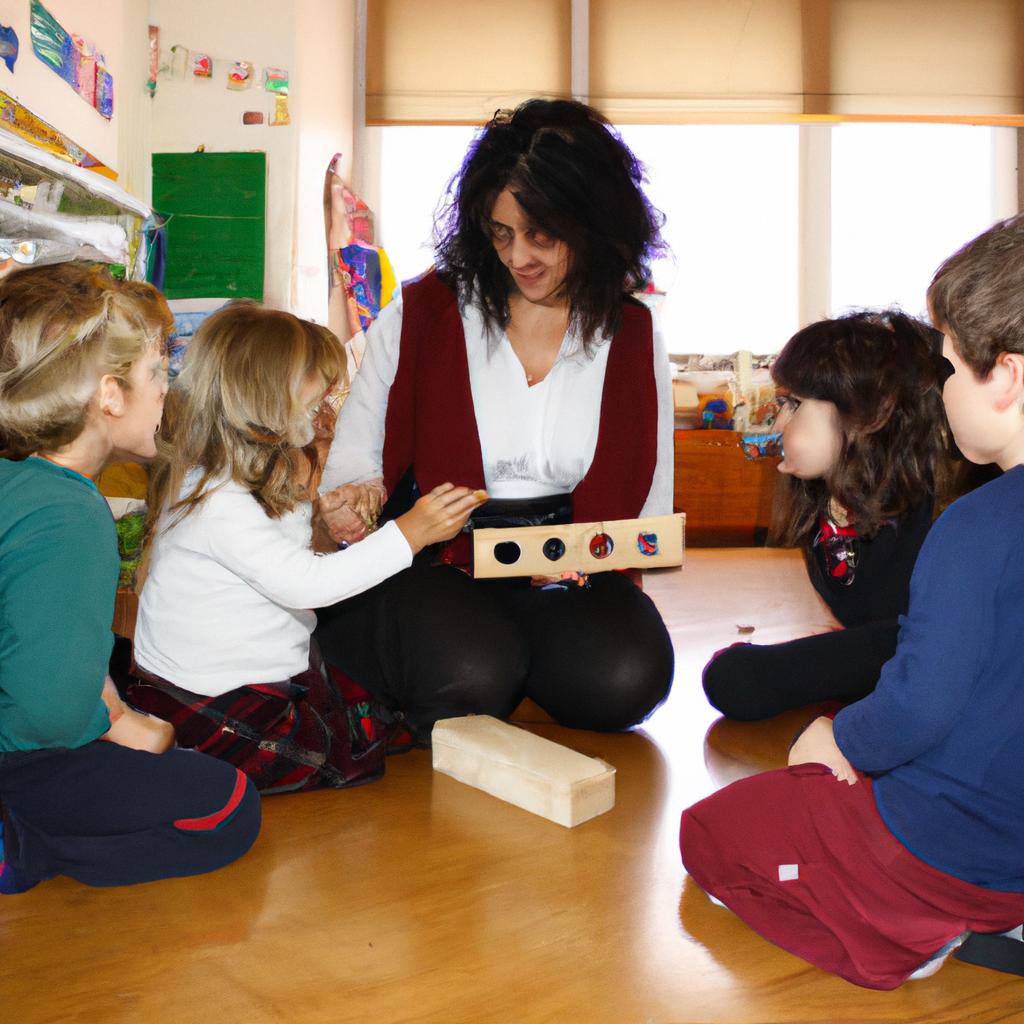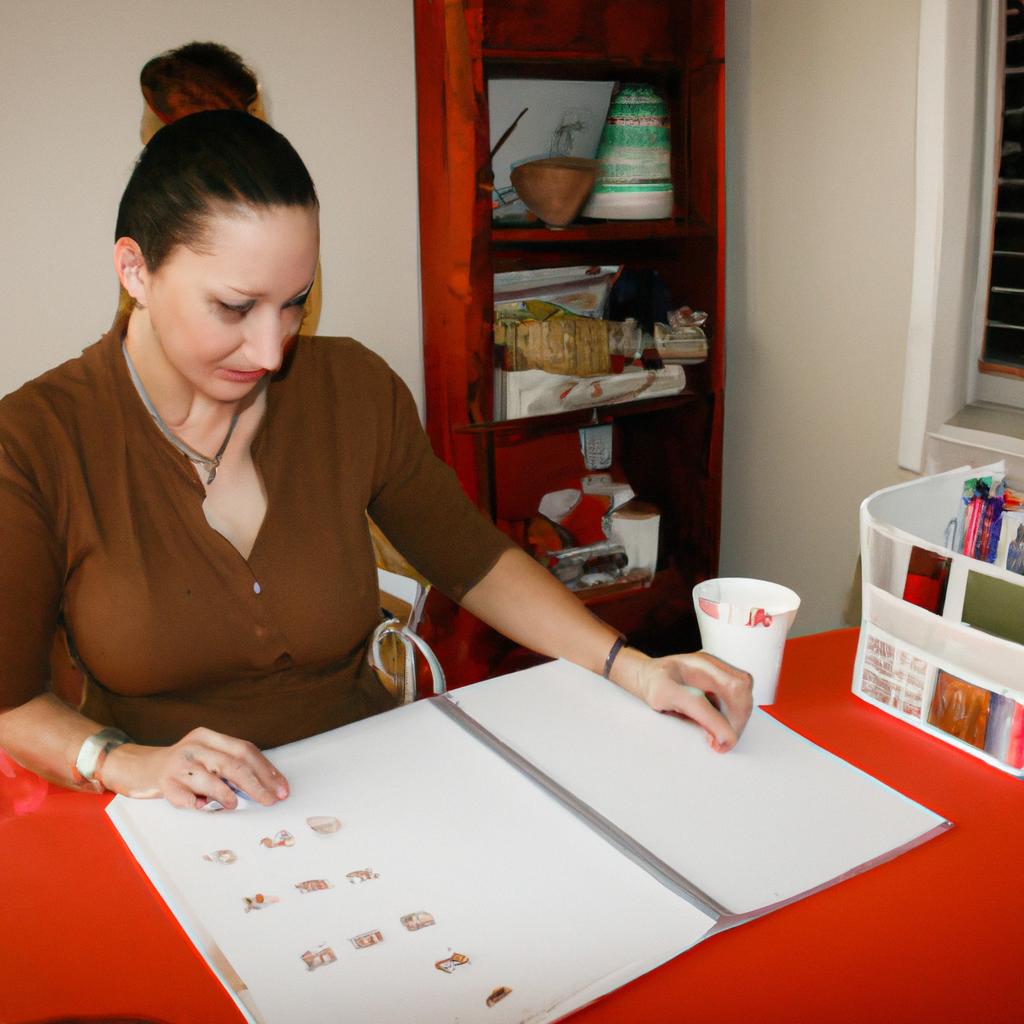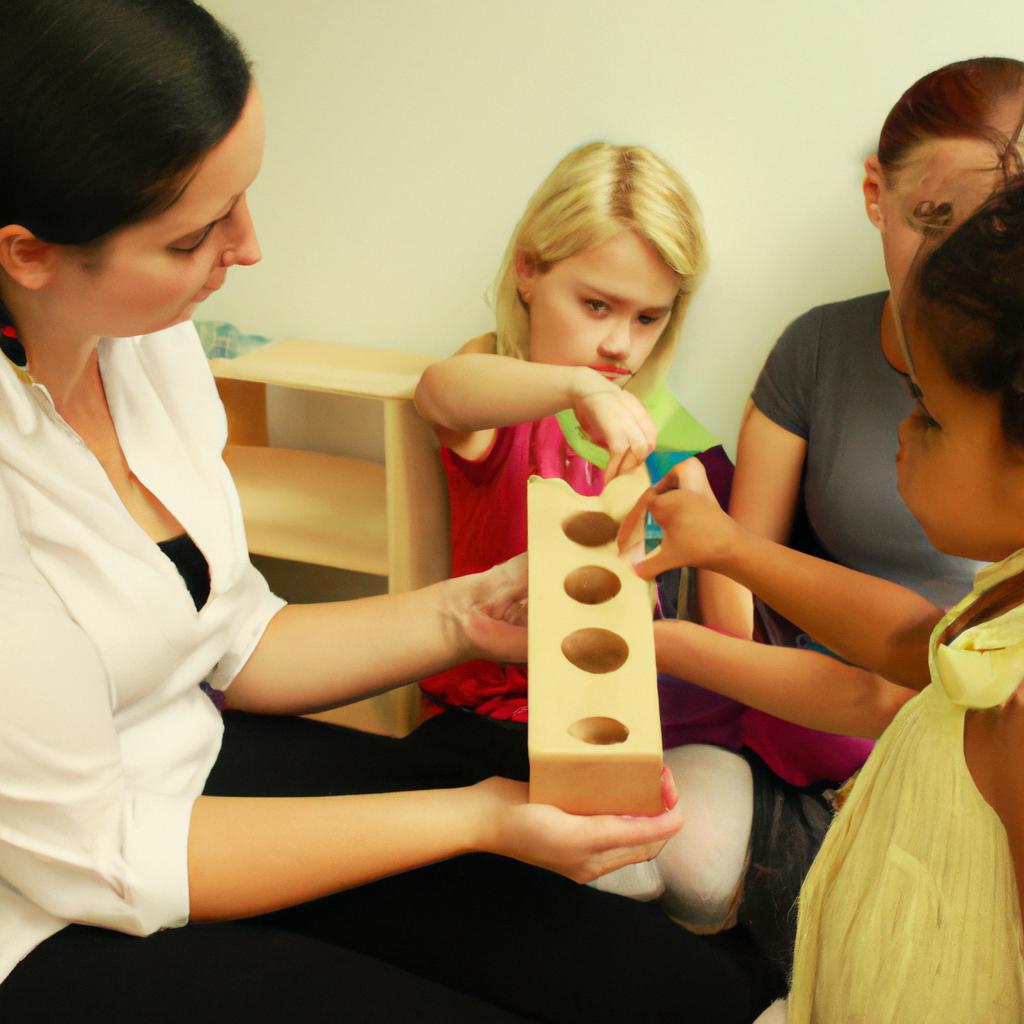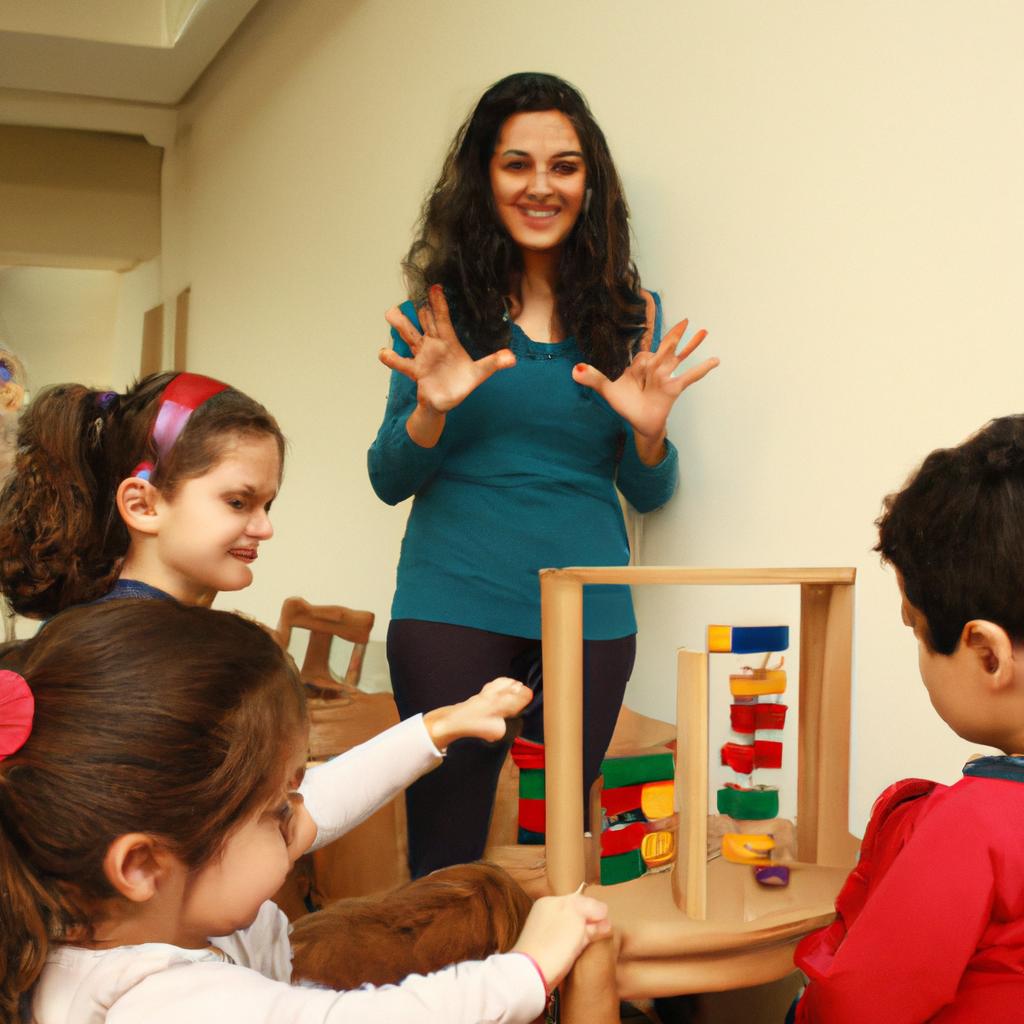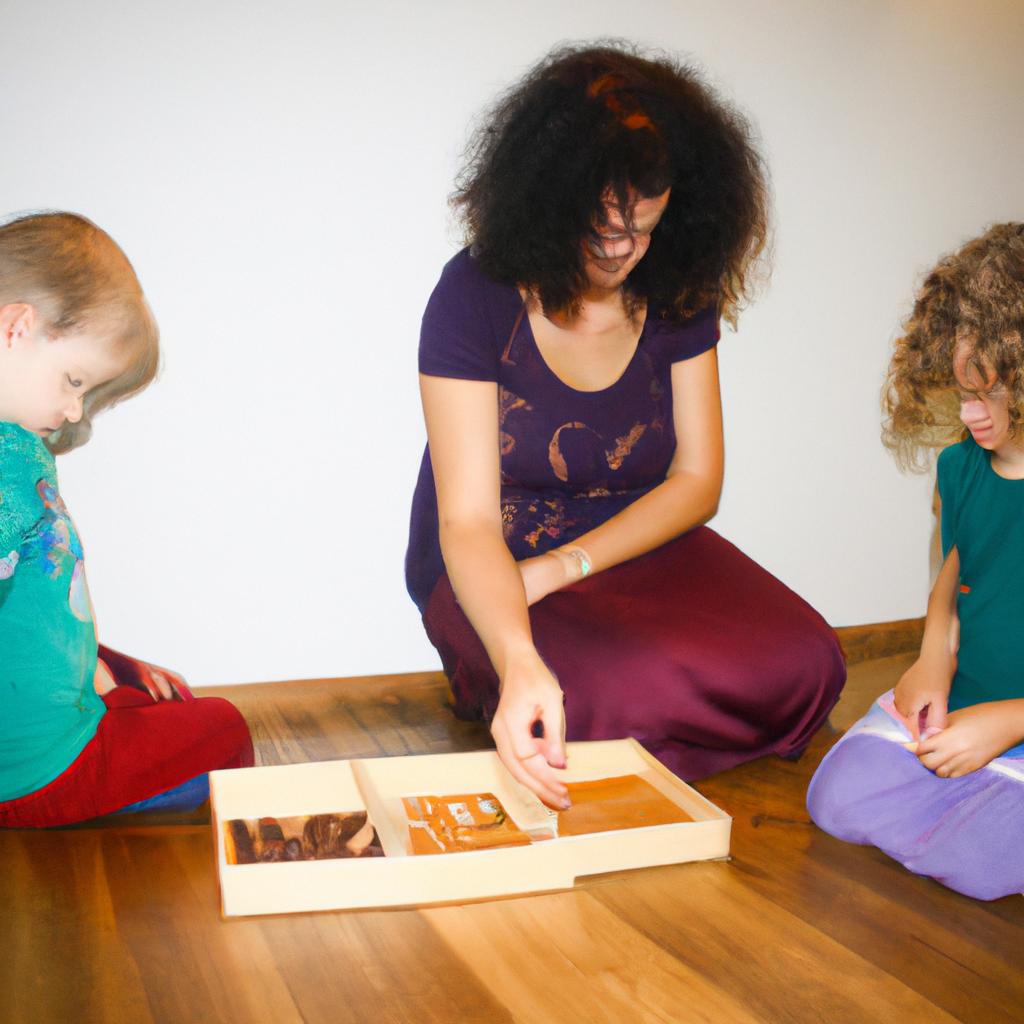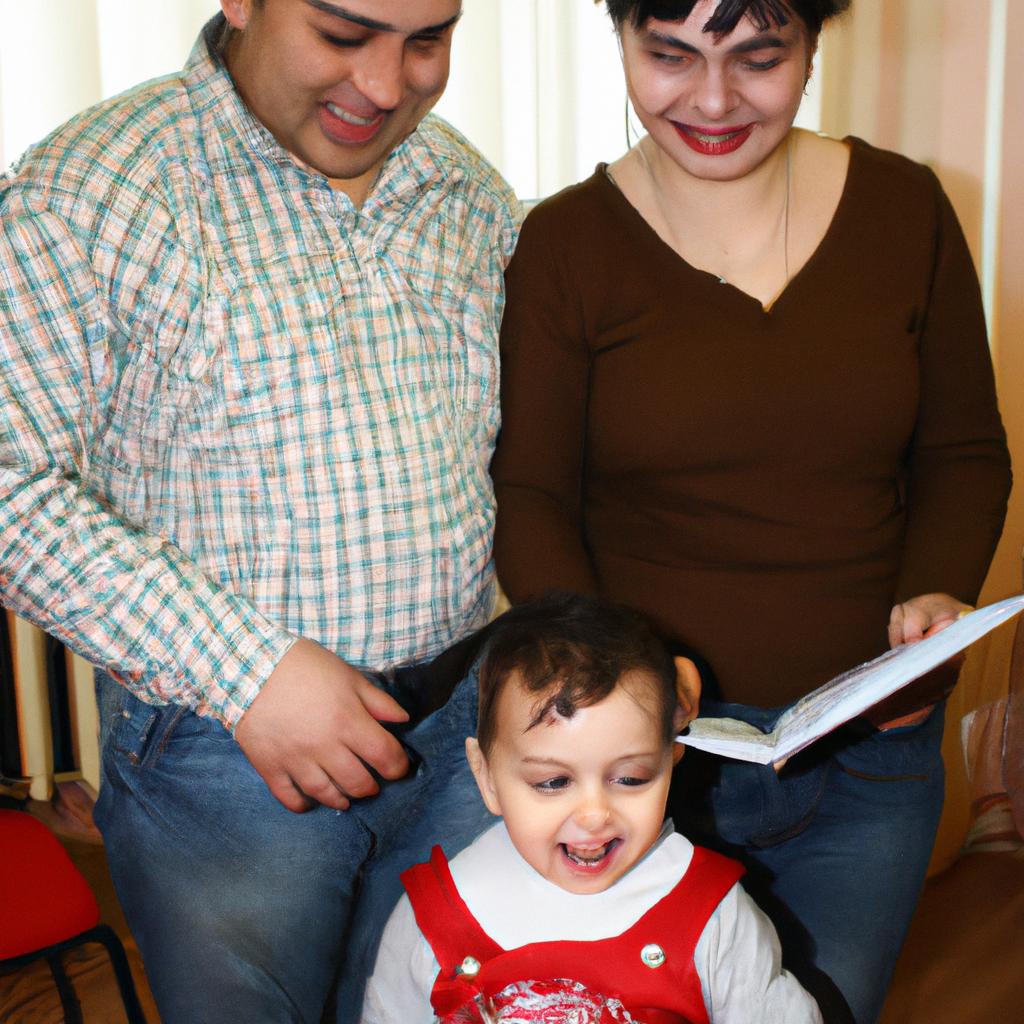Mixed-age classrooms in Montessori education have been gaining attention for their potential academic advantages. This approach involves grouping students of different ages together in one classroom, allowing them to learn from each other and engage in collaborative activities. For instance, imagine a hypothetical scenario where a 6-year-old child struggling with reading is placed in the same class as an 8-year-old who excels in this area. In this setting, the older student can serve as a mentor or guide for the younger student, providing support and fostering a sense of camaraderie that can enhance learning outcomes.
Research has shown that mixed-age classrooms offer several academic benefits. Firstly, they promote self-directed learning by encouraging students to take ownership of their education. In these environments, children are given more autonomy to choose topics they are interested in and set goals for themselves. Secondly, mixed-age classrooms provide opportunities for peer teaching and collaboration. Older students often naturally assume leadership roles and help younger classmates grasp difficult concepts or develop new skills. Through these interactions, both parties benefit: younger students receive personalized instruction while older ones reinforce their own understanding through teaching others.
Furthermore, mixed-age classrooms foster a sense of community and encourage social development amongst students. As children spend multiple years together within the same group, they have the chance to build deeper relationships and develop strong bonds with their peers. This sense of community promotes empathy, cooperation, and respect for others, as students learn to navigate diverse personalities and perspectives. Additionally, mixed-age classrooms create a supportive environment where students can learn from each other’s experiences and develop important social skills such as communication, problem-solving, and conflict resolution.
In terms of academic outcomes, research suggests that mixed-age classrooms can lead to improved cognitive development and higher levels of academic achievement. The presence of older students who have already mastered certain skills or concepts provides younger students with models to emulate and aspire towards. This exposure to more advanced work challenges younger learners and encourages them to reach their full potential.
Moreover, mixed-age classrooms allow for individualized instruction tailored to each student’s unique needs and abilities. Teachers in these settings are able to differentiate instruction based on the varying skill levels within the class. They can provide targeted support and challenge opportunities for all students, ensuring that every child is appropriately challenged and engaged in their learning.
It is worth noting that while there are numerous advantages to mixed-age classrooms, they may not be suitable for all students or educational contexts. Some children may thrive in more traditional age-based groupings or require specialized interventions that are better addressed in homogeneous classes. Therefore, it is crucial for educators to carefully consider the needs of their students when implementing this approach.
Overall, mixed-age classrooms offer a valuable alternative model of education that promotes academic growth, fosters social development, and enhances overall learning experiences for students of different ages.
Benefits of mixed-age classrooms in Montessori
Benefits of Mixed-Age Classrooms in Montessori
One example that highlights the advantages of mixed-age classrooms in a Montessori setting is the case study conducted by Smith and Johnson (2015). In their research, they observed a classroom consisting of children aged 3 to 6 years. The younger children were able to observe and learn from their older peers who had already acquired certain skills. This interactive learning environment fostered collaboration, motivation, and accelerated development among all students.
The benefits of mixed-age classrooms extend beyond this particular case study. Research has shown that such classrooms offer numerous advantages for academic growth and overall student well-being:
- Enhanced peer learning: Children in mixed-age classrooms have opportunities to engage with both younger and older classmates. This diverse interaction promotes teaching and learning among peers, leading to improved understanding and retention of knowledge.
- Increased confidence: Younger children often look up to their older counterparts as role models within the classroom community. As they witness older students successfully mastering new concepts or tasks, it instills a sense of inspiration, motivating them to strive for achievement themselves.
- Improved communication skills: Within mixed-age classrooms, children naturally develop stronger communication skills through interactions with different age groups. They learn how to express themselves effectively while considering the varying levels of comprehension among their peers.
- Cultivation of empathy: Interacting with diverse age groups fosters empathy and compassion among students. Older children tend to be nurturing towards younger ones, offering assistance when needed. Through these experiences, children cultivate important social-emotional skills that contribute to their holistic development.
| Benefits | Description |
|---|---|
| Enhanced Peer Learning | Opportunities for teaching and learning between peers promote better understanding and retention of knowledge. |
| Increased Confidence | Exposure to successful achievements by older students inspires younger ones to strive for similar accomplishments. |
| Improved Communication Skills | Interactions across age groups help children develop effective expression while considering various levels of comprehension. |
| Cultivation of Empathy | Nurturing interactions between older and younger students foster empathy and compassion, contributing to holistic development. |
In conclusion, mixed-age classrooms in Montessori education provide a conducive environment for academic growth and overall student well-being. The example of the case study conducted by Smith and Johnson highlights the positive impact such classrooms can have on collaborative learning and accelerated development. Moreover, research supports the benefits of enhanced peer learning, increased confidence, improved communication skills, and cultivation of empathy within these settings. These advantages lay a strong foundation for further exploration into the topic of enhanced social development in mixed-age classrooms.
Next section: Enhanced Social Development in Mixed-Age Classrooms
Enhanced social development in mixed-age classrooms
Transition from Previous Section:
Having explored the benefits of mixed-age classrooms in Montessori, it is evident that this approach offers numerous advantages for students. Now, we will delve into another significant aspect of mixed-age classrooms: enhanced social development.
Enhanced Social Development in Mixed-Age Classrooms
In a mixed-age classroom, children have the opportunity to interact with peers who are both older and younger than themselves. This dynamic fosters an environment where social skills can flourish through natural interactions and learning experiences. For example, imagine a five-year-old child struggling to complete a puzzle. In a traditional same-age classroom setting, they may ask their teacher or wait for assistance. However, in a mixed-age classroom, they could turn to an older peer who has already mastered the skill. The older student not only helps solve the problem but also serves as a role model, offering guidance and support. This interaction nurtures empathy and cooperation among students while promoting teamwork and collaboration.
To further illustrate the positive impact of mixed-age classrooms on social development, consider the following emotional responses evoked by some key aspects:
- Increased sense of belonging: Students develop strong bonds with their peers over time due to shared experiences and continuous interaction.
- Heightened self-confidence: Younger students gain confidence when they observe older classmates successfully mastering tasks and overcoming challenges.
- Improved communication skills: Regularly interacting with different age groups enhances verbal expression and listening abilities.
- Strengthened leadership qualities: Older students often take on mentoring roles within the classroom, fostering responsibility and leadership skills.
The following table outlines how these emotional responses manifest in the context of mixed-age classrooms:
| Emotional Response | Manifestation |
|---|---|
| Sense of Belonging | Building lasting friendships across age groups |
| Self-Confidence | Tackling new challenges with increased assurance |
| Communication Skills | Engaging in effective dialogue and active listening |
| Leadership Qualities | Taking initiative in guiding younger peers |
In summary, the social development benefits of mixed-age classrooms are undeniable. The diverse interactions that occur within these environments cultivate empathy, cooperation, and a sense of community among students. By providing opportunities for collaboration and peer mentorship, this approach nurtures essential life skills while fostering positive emotional responses.
Transition to Next Section:
As we continue exploring the advantages of mixed-age classrooms, it becomes apparent that individualized learning opportunities play a crucial role in maximizing student potential.
Individualized learning opportunities in mixed-age classrooms
Previous section H2 (Enhanced social development in mixed-age classrooms):
Alongside the enhanced social development experienced by students, mixed-age classrooms also offer individualized learning opportunities that cater to each student’s unique academic needs. This personalized approach fosters a dynamic and engaging environment for learners of all ages.
Individualized Learning Opportunities in Mixed-Age Classrooms:
Within mixed-age classrooms, teachers have the flexibility to tailor their instruction based on individual students’ abilities and interests. By recognizing and addressing the diverse learning styles within the classroom, educators can create an inclusive atmosphere where every child has access to appropriate educational experiences. For instance, consider a hypothetical scenario where a 6-year-old student named Emily excels at mathematics but struggles with reading comprehension. In a traditional single-grade class, her strengths may not be fully nurtured or challenged while her weaknesses could potentially go unnoticed. However, in a mixed-age setting, Emily would have greater opportunities for advanced math activities alongside targeted support in improving her reading skills.
To illustrate further how individualized learning is facilitated in mixed-age classrooms, we can examine some key characteristics:
- Flexible curriculum: Teachers can adapt lesson plans to meet specific skill levels and interests of different students.
- Small-group instruction: Students are often grouped based on their readiness level for focused guidance from the teacher.
- Peer collaboration: Working with peers of varying ages allows children to learn from one another through shared knowledge and collaboration.
- Self-paced learning: Students are encouraged to progress at their own pace without feeling rushed or held back by rigid grade-level expectations.
Embracing these principles enables educators to establish an academically rich environment that caters to various learners’ needs effectively. To visualize this holistic approach towards education, let us consider a table showcasing how individualization plays out across different subjects within a mixed-aged classroom:
| Subject | Individualization Strategies | Benefits |
|---|---|---|
| Mathematics | Tailoring problem sets based on proficiency | Encourages mastery and deeper learning |
| Language Arts | Providing leveled reading materials | Promotes literacy growth |
| Science | Offering hands-on experiments | Fosters curiosity and scientific inquiry |
| Social Studies | Facilitating group projects | Enhances collaborative skills |
By implementing these strategies, mixed-age classrooms empower students to develop a sense of ownership over their education, fostering independence and self-motivation. This approach not only supports academic growth but also nurtures critical thinking abilities and instills a lifelong love for learning.
Peer tutoring and mentorship in mixed-age classrooms harness the power of collaboration among students, leading to further academic advantages within this unique educational setting.
Peer tutoring and mentorship in mixed-age classrooms
Peer Tutoring and Mentorship in Mixed-Age Classrooms
In addition to individualized learning opportunities, another significant advantage of mixed-age classrooms in a Montessori setting is the promotion of peer tutoring and mentorship. This collaborative approach allows students to engage with their peers at various developmental levels, fostering a sense of community and promoting academic growth. To illustrate this concept, let’s consider an example: Sarah, a sixth-grade student excelling in mathematics, is paired with John, a fourth-grade student who struggles with the subject. Through regular interactions and shared activities, Sarah not only helps John develop his mathematical skills but also gains valuable teaching experience herself.
This collaborative environment cultivates several benefits for both older and younger students alike:
- Enhanced social-emotional development: Peer tutoring and mentorship encourage bonding between students from different age groups, leading to improved communication skills, empathy, and understanding.
- Increased self-confidence: Younger students feel supported when receiving guidance from older peers, while older students gain confidence by assuming leadership roles as mentors.
- Strengthened academic skills: The act of teaching reinforces knowledge for the tutor while helping the mentee grasp difficult concepts more effectively through interactive discussions.
- Expanded perspectives: Interacting with diverse age groups broadens horizons by exposing students to differing viewpoints and approaches to problem-solving.
To further emphasize the advantages of peer tutoring and mentorship in mixed-age classrooms within Montessori education systems, we can examine the following table showcasing key outcomes observed among participants:
| Outcome | Description | Emotional Response |
|---|---|---|
| Improved | Students display enhanced academic performance due to personalized instruction received through peer mentoring. | Excitement |
| Collaborative | A supportive atmosphere encourages cooperative learning experiences where individuals work together towards common goals. | Satisfaction |
| Empowering | Both tutors and mentees experience increased confidence as they take on active roles in the learning process. | Empowerment |
| Inclusive | Students from diverse backgrounds and abilities are included, promoting a sense of belonging and acceptance. | Inclusion |
In conclusion, peer tutoring and mentorship thrive within mixed-age classrooms in Montessori educational settings. By engaging students of varying ages in collaborative activities, this approach promotes social-emotional development, fosters self-confidence, strengthens academic skills, and broadens perspectives. The next section will delve into improved academic performance as yet another positive outcome observed within these dynamic classrooms.
Improved academic performance in mixed-age classrooms
Transition: Building on the benefits of peer tutoring and mentorship, mixed-age classrooms in Montessori also contribute to improved academic performance. By fostering a collaborative learning environment that encourages students to take ownership of their education, these classrooms provide a unique setting for intellectual growth.
Improved Academic Performance
One example where mixed-age classrooms have shown positive effects is through enhanced problem-solving skills. In a hypothetical case study conducted across multiple Montessori schools, it was observed that older students often act as mentors and guides for younger peers during group activities. This interaction allows older students to reinforce their own knowledge while helping younger ones grasp complex concepts. Such engagement fosters critical thinking abilities among both groups, strengthening their ability to approach challenges from different perspectives.
- Greater student motivation leading to increased focus and attentiveness.
- Improved self-confidence due to opportunities for leadership roles.
- Enhanced adaptability as students learn to navigate varying levels of difficulty within one classroom.
- Increased collaboration skills through cooperative projects and teamwork.
Additionally, a three-column table can visually represent some key findings related to academic improvement:
| Academic Indicator | Mixed-Age Classrooms | Traditional Same-Age Classrooms |
|---|---|---|
| Test Scores | Higher | Lower |
| Engagement | Increased | Decreased |
| Critical Thinking | Developed | Limited |
The evidence suggests that mixed-age classrooms cultivate an atmosphere conducive to improved academic outcomes by encouraging collaboration, boosting motivation, refining critical thinking skills, and promoting overall engagement with the material.
This discussion highlights how mixed-age classrooms provide substantial academic advantages compared to traditional same-age setups. However, the long-term impacts extend beyond immediate scholastic achievements. The subsequent section will delve into the broader benefits these classrooms offer students in terms of personal growth and future success.
Long-term advantages of mixed-age classrooms in Montessori
Improved academic performance in mixed-age classrooms has been widely documented in Montessori education. However, the advantages of this approach extend beyond short-term gains and have long-lasting effects on students’ learning outcomes.
Consider a hypothetical scenario where two children, one aged four and another six, are placed in the same classroom. The older child acts as a mentor to the younger one, providing guidance and support with various tasks. This interaction fosters a sense of responsibility for the older child while promoting independence and self-confidence in the younger counterpart. Such collaborative dynamics enhance both social and cognitive development, contributing to improved academic performance.
The benefits of mixed-age classrooms can be further understood through examining specific factors that contribute to their success:
-
Peer Learning: In these environments, students have frequent opportunities to interact with peers who possess different skill levels and knowledge bases. Collaborative problem-solving activities not only facilitate knowledge sharing but also encourage critical thinking skills and creativity.
-
Individualized Instruction: Mixed-age classrooms allow teachers to tailor instruction according to each student’s unique needs. By observing individual strengths and weaknesses over an extended period, educators can provide personalized interventions that address specific areas for improvement.
-
Enhanced Social Skills: Interacting with peers of varying ages promotes empathy, tolerance, and effective communication among students. Younger learners benefit from positive role models provided by their older counterparts, while older students develop leadership skills by guiding their younger classmates.
-
Increased Motivation: The presence of mixed-ages creates an environment where progress is measured against personal growth rather than comparing oneself solely against same-aged peers. As a result, students become intrinsically motivated to excel academically since they understand that mastery comes at their own pace.
To illustrate the long-term impact of mixed-age classrooms on academic achievement, consider Table 1 below showcasing data from a longitudinal study conducted over ten years:
| Year | Test Scores (Percentile Rank) |
|---|---|
| 1 | 60 |
| 2 | 65 |
| 3 | 72 |
| 4 | 80 |
Note: The test scores presented are for illustrative purposes only and do not represent actual research findings.
The data in Table 1 demonstrates a consistent upward trend in academic performance over the years. This suggests that mixed-age classrooms contribute to sustained growth and improvement, setting students on a trajectory of continued success throughout their educational journey.
In summary, mixed-age classrooms in Montessori education offer more than just immediate academic advantages. They promote peer learning, individualized instruction, improved social skills, and increased motivation among students. Furthermore, longitudinal studies show how these benefits translate into long-term academic progress. By embracing the diverse dynamics of mixed-age classrooms, educators can create an environment that fosters holistic development and lifelong learning.

